Shower buying guide
Shower buying guide
Introduction
A shower is a must-have for any home. But, if you’re looking to buy a new one, the choice can be overwhelming. So, we’ve put together this shower buying guide to help you choose.
It provides a detailed look at the different types of showers available, what they are, the type of water system they’re best for and their pros and cons. It also covers types of shower heads, valves and equipment, plus shower enclosures, bases and glass. Finally, it gives some tips on installation and maintenance of showers, key considerations before buying and answers some frequently asked questions.
You can view our range of showers here.
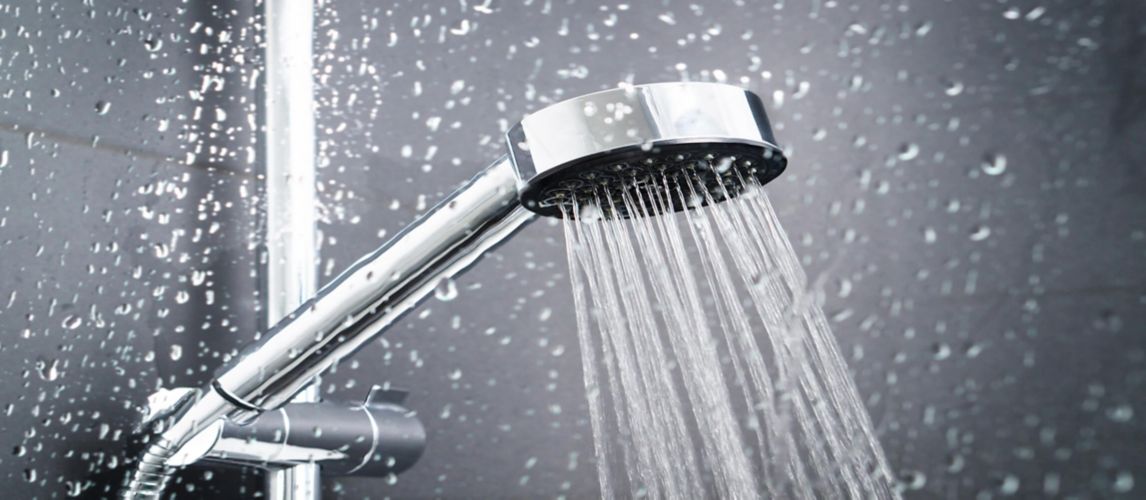
How to Choose a Shower
When choosing a shower, there are three important factors to consider:
-
Water pressure: Water pressure can be high or low, and it’s influenced by the power of the mains cold water supply and the type of water system installed. Water pressure determines how powerful the shower will be and the type of shower needed.
-
Water or boiler system: Homes have one of three systems. A low-pressure gravity-fed system has a cold water storage tank in the loft and a hot water storage tank in an airing cupboard. An unvented high-pressure system has a hot water storage tank but no cold water storage. And a high-pressure combi boiler system is mains fed and has no water storage at all.
-
Boiler tank capacity: For homes with gravity-fed or unvented systems that store hot water, the size of the tank is important. If the tank is small, it will run out of hot water quickly if the shower has a high flow rate.
Types of Showers
Showers come in contemporary and traditional styles and can be fitted over a bath, within a shower enclosure or freestanding in a wet room. But there are many different types of showers to choose from, and some are better suited to certain water pressures and systems than others.
In this section, we look at the types of showers available, which water pressure and system they work with and their pros and cons.

Manual mixer showers explained
Manual mixer showers mechanically mix hot and cold water to get it to the desired temperature before delivering it out of the shower head. They come with different types of shower handles, including:
- Single lever: pulls out to turn the shower on and turns to control the temperature
- Rotary or sequential: a dial that turns the shower on and controls the temperature
- Concentric: an outer wheel to adjust flow and an inner one to adjust the temperature
- Dual controlled: separate controls to adjust flow and temperature
- Bar mixers: a bar with dials at either end to control flow and temperature
Water pressure/system needed: They need a hot and cold water supply and are best used with high-pressure combi boilers and unvented systems with a good supply of hot water. They can also be used with a gravity-fed system, but if the water pressure is very low, it can be increased by installing a shower pump. Some models can only be used with high-pressure systems, so always check before buying.
Best for: Homes with a large hot water tank.
Pros:
- Easy to install and use
- They don’t use electricity (unless a pump is installed)
Cons:
- There’s no thermostatic temperature control, so they’re not suitable for families with young children due to the risk of scolding
- They won’t provide hot water if the boiler fails
- Water pressure will dip if water is used elsewhere in the home at the same time
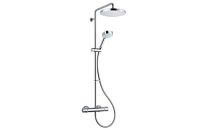
Thermostatic mixer explained
Thermostatic mixer showers are like manual mixer showers, but they have a built-in thermostatic valve that keeps the water at a constant temperature. They are available with the same choice of controls as a manual mixer shower as described above.
Water pressure/system needed: They need a hot and cold water supply and are best used with high-pressure combi boilers and unvented systems with a good supply of hot water. They can also be used with a gravity-fed system and a shower pump to increase the water pressure. Some models can only be used with high-pressure systems, so always check before buying.
Best for: Families with young children or elderly people as they reduce the risk of scalding.
Pros:
- Reliable control over the temperature and reduces the risk of scalding
- The temperature isn’t affected by water being used elsewhere in the house
- Easy to install and use
- They don’t use electricity (unless a pump is installed)
Cons:
- They won’t provide hot water if the boiler fails
- Water pressure will dip if water is used elsewhere in the home at the same time
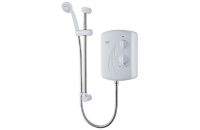
Electric showers explained
Electric showers run off the cold water supply and heat water on demand as it passes over an element in the unit before delivering it out of the shower head. They are available in various wattages (the higher the wattage, the more powerful the water flow) and have dial or push-button controls.
Water pressure/system needed: They need a cold water supply and an electricity supply. Most models require a high pressure, mains fed supply. But some are suitable for a gravity-fed supply, although you may need to install a shower pump if the water pressure is low. See our shower pump buying guide for more information.
Best for: Homes with a combi boiler or a small hot water cylinder.
Pros:
- Easy to install thanks to multiple cable and water entry points
- They are energy efficient as they only heat water as it’s needed
- They don’t use up any stored hot water
- They aren’t affected by boiler failures
- The temperature isn’t affected by water being used elsewhere in the house
- Ideal for installation in new ensuites or shower rooms as they only require a cold water supply
- They have a low flow rate compared to pump-assisted showers, so they can save money on water bills
Cons:
- Must be installed by a qualified electrician and plumber
- They won’t work if there is a power cut
- The heating element can be affected by limescale in hard water areas
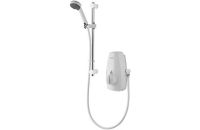
Power showers explained
Power showers use hot and cold water feeds, which are mixed together in the unit to reach the desired temperature. They are also connected to the electricity to run an in-built pump that boosts the water pressure. They are available with thermostatic or manual temperature controls, with separate dials to adjust flow and temperature.
Water pressure/system needed: They need hot and cold water and an electricity supply. They are only suitable for use with low-pressure water systems.
Best for: Homes with low-pressure gravity-fed water systems and a large hot water cylinder.
Pros:
- Boosts water pressure without the need for an additional shower pump
- Cheaper and easier to install compared to installing a mixer shower and pump separately
- Easy to install thanks to multiple cable and water entry points
Cons:
- They use more water and energy than other types of showers, which will increase water and energy bills
- Must be installed by a qualified electrician and plumber
- They won’t work if there is a power cut or boiler failure
- They are more expensive than most other types of showers
You can view our range of power showers here.
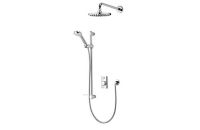
Digital and smart showers explained
Digital showers are electrical thermostatic mixer showers that use digital technology to allow users to set a precise water temperature. Some models also have a remote control to turn the shower on and off. A smart shower has the added benefit of connecting to smartphones and smart speakers. Settings, such as temperature and flow for different people, can be customised through the smartphone, and the shower can be turned on and off with voice commands. Digital and smart showers mix hot and cold water to get it to the desired temperature before delivering it out of the shower head.
Water pressure/system needed: They need hot and cold water and an electricity supply. They are available for all types of water systems and pressures. However, each model is only suited to high or low water pressure, not both. So always check to ensure you buy the right one. Models designed for low-pressure systems often include a built-in pump to increase the water pressure.
Best for: People that love the convenience of using technology and have other smart devices in their homes.
Pros:
- Reliable and accurate control over the temperature and reduces the risk of scalding
- Smart models add convenience and integrate seamlessly with popular smart home systems such as Amazon Alexa and Google Home
- The temperature isn’t affected by water being used elsewhere in the house
- Low-pressure models boost water pressure without the need for an additional shower pump
Cons:
- Must be installed by a qualified electrician and plumber
- They won’t work if there is a power cut or boiler failure
- They are more expensive than other types of showers
Types of Shower Heads
Showers come with different types of shower head attachments, and the chosen type can significantly affect the showering experience. The different types of shower heads are:
-
Fixed: These shower heads are permanently fixed in place, usually on the ceiling or wall. Although some can be tilted, they can’t be removed.
-
Riser kits: These shower heads slot into a bracket that’s attached to a riser rail (a vertical pole) fixed to the wall. Riser kit heads can be moved up and down the rail to adjust the height for different users. And the head can be removed for hand-held use, making them more versatile than fixed shower heads.
-
Shower tower: These showers feature an overhead shower head, shower valves, controls, and pipework in one column or panel. Some also have a detachable shower handset.
-
Combination: These shower heads give users a fixed and riser kit shower head in one, allowing maximum versatility.
All types of shower head fittings come in a variety of contemporary and traditional designs, with heads in different sizes, shapes, and finishes. Some also have multiple spray and water flow options.
Types of Shower Valves
A shower valve is the part of a mixer or thermostatic shower that turns the appliance on and off and allows users to select the water flow and temperature. They mix hot and cold water to get the desired temperature. The two most common types of shower mixing valves are thermostatic shower valves and pressure balance valves.
Thermostatic shower valves have two handles; one to control the temperature and one to control the flow. Types of thermostatic shower valves include models with concentric controls (with an outer and inner wheel), dual controls (with separate controls on a panel) and bar mixers (a bar with dials at either end).
Pressure balance valves only have one handle that turns the shower on and controls the temperature. Types of handles include a single lever (pulls out to turn the shower on and turns to control the temperature) and rotary or sequential dials.
Shower valves come in exposed and concealed options. The exposed option means the whole valve and its controls are fixed externally to the shower enclosure wall, so they are visible. With the concealed option, the valve is hidden behind the wall cavity, and only the controls are visible.
Other Shower Options
This section covers some of the other options you’ll come across when creating different types of shower designs within a bathroom or ensuite.
Types of shower enclosures
Shower enclosures come in a wide variety of sizes and designs. Different types of shower enclosures include shapes such as:
-
Offset quadrant
-
Quadrant
-
Square
-
Rectangular
-
Pentagonal
-
D-shaped
They can also come with different types of shower doors, including bi-fold, single or double sliding doors, hinged or pivot doors, or no doors at all (called walk-in shower enclosures). And they are available with framed or frameless glass.
Types of shower tray and bases
To create a shower enclosure, you’ll also need a suitable shower tray or base. They come in various shapes and sizes to fit any bathroom and type of shower enclosure frame. They can be low or high-sided to accommodate the plumbing (i.e., whether the pipes are at floor level or sunk below the floor) and are available in a variety of materials, including acrylic-capped stone resin, stone resin and PVC.
Types of shower glass
Shower enclosures and bath screens come with different types of shower glass. Most use 5mm, 6mm, or 8mm toughened safety glass, the most common type being tempered glass. They are also available in several designs, from clear tinted and frosted glass to patterned glass. Some can also have an anti-limescale coating which helps keep the glass looking its best, preventing scum build-up and making them easier to clean.
Types of Shower Equipment
When creating a new showering area or replacing parts of an existing one, there are a few pieces of equipment you may need to buy separately. This section gives an overview of the most common types of shower equipment and shower spares and parts you may need:

Types of shower hose connections: shower hoses connect the shower unit or valve to the shower head. They come in various lengths and colours, and some are reinforced to make them resistant to kinks that can restrict water flow. When buying, check if they work with the property’s water pressure, as they vary. Also, check the bore size to ensure it will fit the existing shower unit and head.
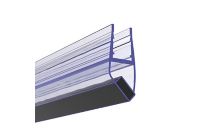
Types of shower door seals: shower door seals are plastic strips that slide onto the bottom of shower doors to make the enclosure watertight. They are usually made of clear plastic and come in various lengths that can be cut to size. Some also have magnetic strips attached, which work with compatible shower bases.

Types of shower mixers: thermostatic mixer showers have a cartridge inside the unit that may wear out over time. Spare cartridges are available so they can be replaced without having to change the whole shower unit. There are screw-in and push-in versions, and they come in different sizes, so always check the shower’s user manual to ensure you purchase the correct size.
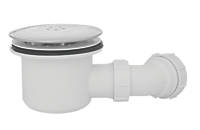
Types of shower waste traps: shower traps take waste water out of a property to a drain and prevent smells from coming up into the room. The waste pipe is usually white plastic, and the visible part comes in chrome or stainless steel. It’s unscrewable for cleaning and removing clogged hairs. Shower traps come in various diameters, from 40mm to 122mm, so always check which size you need before buying.
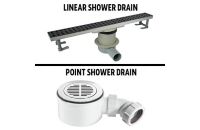
Types of shower drains: shower drains take waste water out of a property. There are two different types of shower drains: a point drain and a linear drain. A point drain is the same as a shower trap, as described above. They work with shower enclosure trays or small tiles. A linear drain is a long, rectangular drain that spans the width of the shower area. They work well with large or small floor tiles.
Installation and Maintenance of Showers
Manual and thermostatic mixer showers are relatively easy to install if you are replacing an old model, and installation can be carried out by a competent DIYer. However, a qualified plumber and electrician must install electric, power, digital and smart showers due to the risks of mixing water and electricity.
The time it takes to fit a shower will depend on the complexity of the job. A like-for-like replacement may only take an hour, while installing a shower in a new location is more complex and could take up to eight hours to add new pipes and electrical connections. Installation of a completely new shower enclosure can take three to five days.
Once a shower is installed, it’s important to keep the area maintained. Top tips:
-
Rinse the area with clean water after every use
-
Leave the door ajar, run an extractor fan, or open a window to disperse humidity and prevent mould and mildew
-
Clean it regularly to remove limescale and unclog the drain.
Key Considerations When Buying a Shower
We’ve covered the most important information above to help you choose the right shower for your needs, but here are a few more things to consider:
-
Who will be using the shower?
There are a few options to think about if the shower will be used for certain groups of people. For example, showers with multiple heads, detachable hoses and thermostatic showers are ideal for small children or washing pets. Shower seats and grab rails can be installed for people with mobility problems. And there are also shower heads designed for commercial use. -
What safety features are there?
Showers have a few safety features available, which reduces the risk of accidents. For example, a maximum temperature safety button on the temperature control prevents the heat from being turned up above a pre-set temperature to reduce the risk of scalding. Thermostatic protection ensures the water always stays at a constant temperature, even when water is used elsewhere in the home, to prevent scalding or getting a cold blast of water. And some electric, power, digital and smart showers have an automatic shutdown function that switches the shower off if the water supply fails. -
What size and space is the bathroom?
The size and space available will determine what type of showering area a bathroom can have. For example, a shower enclosure and separate bath could be installed if the bathroom is large enough. But if it’s small, choose between having the shower over a bath or within a shower enclosure. Shower enclosures come in many shapes and sizes, and some fit into small spaces if necessary. - What power or pressure do you need?
The power of electric showers is measured in kilowatts. The higher the kilowatts, the more powerful the shower will be. However, consider the home’s water pressure as low water pressure may result in slow water flow. If a more powerful shower is preferred, homes with low-pressure water systems can fit a power shower or install a shower pump with any other shower type to boost the pressure.
